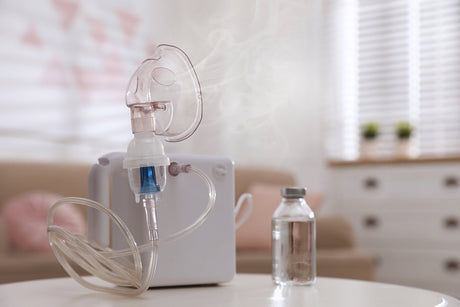COPD is not a single disease, but a term that covers several lung diseases that cause airflow obstruction. It causes breathing difficulties, coughing, wheezing, and chest tightness. It can also lead to serious complications such as heart problems, infections, and lung cancer.
But despite being a widespread and serious disease, there are many myths and misconceptions about COPD that can prevent people from getting the right diagnosis, treatment, and support. In this article, we will debunk some of the most common COPD myths and provide you with the facts you need to know.
What is COPD?
COPD encompasses a range of chronic lung conditions. The most common types of COPD are chronic bronchitis and emphysema. Chronic bronchitis is inflammation of the airways that causes mucus production and coughing. Emphysema is damage to the air sacs in the lungs that reduces their ability to exchange oxygen and carbon dioxide.
COPD is usually caused by long-term exposure to irritants that damage the lungs, such as cigarette smoke, air pollution, dust, or chemicals. However, some people may have a genetic predisposition to developing COPD, such as those with alpha-1 antitrypsin deficiency.
COPD is a progressive disease, which means it gets worse over time. There is no cure for COPD, but there are treatments and lifestyle changes that can help slow down the progression of the disease, relieve symptoms, improve quality of life, and prevent complications.
Discover effective ways to manage COPD, like breathing techniques.
Myth 1: COPD only affects smokers
One of the most common myths about COPD is that it only affects smokers. While smoking is the leading cause of COPD, it is not the only one. According to the World Health Organization (WHO), about 25% of people with COPD have never smoked in their lives. Other risk factors for COPD include:
- Exposure to secondhand smoke
- Exposure to indoor or outdoor air pollution
- Exposure to occupational dusts or chemicals
- Having a family history of COPD or alpha-1 antitrypsin deficiency
- Having asthma or other respiratory diseases
Therefore, anyone who has symptoms of COPD, such as chronic cough, shortness of breath, wheezing, or chest tightness, should see a doctor for a proper diagnosis, regardless of their smoking history.
Shop for respiratory essentials here.
Myth 2: COPD is an old person's disease
Another myth about COPD is that it only affects older people. While COPD is more common in older adults, it can affect anyone at any age. According to the American Lung Association (ALA), about half of the people with COPD are under 65 years old. In fact, some people may develop COPD as early as their 30s or 40s.
The reason why COPD may seem like an old person's disease is that it takes years for the lung damage to accumulate and cause noticeable symptoms. Many people with COPD may not be aware of their condition until they reach their 50s or 60s. However, early diagnosis and treatment can make a big difference in slowing down the progression of the disease and preventing complications.
Therefore, anyone who has risk factors for COPD or experiences breathing difficulties should get tested for COPD as soon as possible.
Myth 3: COPD is not a serious disease
Some people may think that COPD is not a serious disease because it does not cause pain or other visible signs of illness. However, this is far from the truth. COPD is a serious and potentially life-threatening disease that can have a significant impact on your health and well-being.
According to the WHO, COPD is the third leading cause of death worldwide, killing more than 3 million people every year. COPD can also cause many complications, such as:
- Respiratory infections
- Heart problems
- Lung cancer
- Depression
- Anxiety
- Osteoporosis
- Malnutrition
- Muscle weakness
COPD can also affect your daily activities, such as walking, climbing stairs, working, or enjoying hobbies. It can also affect your social and emotional well-being, such as your relationships, self-esteem, or mood.
Therefore, anyone who has COPD should take their condition seriously and follow their doctor's advice on how to manage their symptoms and prevent complications.
Myth 4: COPD cannot be treated
Some people may believe that there is nothing they can do to treat their COPD because there is no cure for it. However, this is not true. While there is no cure for COPD, there are many treatments and lifestyle changes that can help you live better with your condition.
Some of the treatments for COPD include:
- Medications: There are different types of medications that can help you breathe easier, such as bronchodilators, corticosteroids, antibiotics, or mucolytics. Your doctor will prescribe the best medication for you based on your symptoms and the severity of your disease.
- Oxygen therapy: If your blood oxygen level is low, you may need supplemental oxygen to help you breathe better. Oxygen therapy can be delivered through a nasal cannula, a mask, or a portable device that you can carry with you.
- Pulmonary rehabilitation: This is a program that combines exercise, education, and counseling to help you improve your physical and mental health. Pulmonary rehabilitation can help you increase your lung function, endurance, strength, and quality of life.
- Surgery: In some cases, surgery may be an option for people with severe COPD who do not respond well to other treatments. Surgery may involve removing damaged parts of the lungs (lung volume reduction surgery) or replacing the lungs with healthy ones (lung transplantation).
Some of the lifestyle changes that can help you manage your COPD include:
- Quitting smoking: This is the most important thing you can do to slow down the progression of your disease and improve your symptoms. Quitting smoking can also reduce your risk of developing other diseases, such as heart disease or cancer.
- Avoiding triggers: You should avoid or limit your exposure to anything that can irritate your lungs, such as air pollution, dust, smoke, or chemicals. You should also avoid or treat any respiratory infections, such as colds or flu, that can worsen your symptoms.
- Eating healthy: You should eat a balanced diet that provides you with enough calories, protein, vitamins, and minerals to maintain your weight and muscle mass. You should also drink plenty of water to keep your mucus thin and easy to cough up.
- Exercising regularly: You should do physical activities that are suitable for your fitness level and that can help you improve your lung function, stamina, and mood. You should consult your doctor before starting any exercise program and follow their guidance on how to exercise safely and effectively.
- Managing stress: You should find healthy ways to cope with stress, such as meditation, relaxation techniques, hobbies, or social support. Stress can worsen your symptoms and affect your mental health.
Therefore, anyone who has COPD should work with their doctor to find the best treatment plan for them and follow it consistently.
Myth 5: COPD is the same as asthma
Some people may confuse COPD with asthma because they have similar symptoms, such as coughing, wheezing, and shortness of breath. However, COPD and asthma are different diseases that have different causes, treatments, and outcomes.
Asthma is a chronic inflammatory disease that affects the airways and causes them to narrow and swell. Asthma is usually triggered by allergens, such as pollen, dust mites, or animal dander. Asthma can affect people of any age, but it often starts in childhood.
COPD is a chronic obstructive disease that affects the airways and the air sacs in the lungs. COPD is usually caused by long-term exposure to irritants that damage the lungs, such as cigarette smoke or air pollution. COPD usually affects older adults who have a history of smoking or exposure to other risk factors.
The main difference between asthma and COPD is that asthma is reversible and COPD is not. This means that asthma symptoms can be controlled with medications and avoiding triggers. COPD symptoms cannot be reversed with medications or avoiding triggers. However, both diseases can be managed with proper treatment and lifestyle changes.
Therefore, anyone who has breathing difficulties should see a doctor for a correct diagnosis and treatment.
Facts about COPD help manage the condition
When it comes to COPD, distinguishing facts from myths is paramount to managing the condition effectively. Remember, COPD isn't just a smoker's problem, and it doesn't equate to an inevitable decline in health. With the right knowledge, treatment, and lifestyle adjustments, individuals living with COPD can lead fulfilling lives.
Understanding the truth about COPD empowers you to take control of your health and well-being. Don't let misconceptions hold you back; embrace the facts, seek medical guidance, and step towards a healthier future.
FAQs
Q: How is COPD diagnosed?
COPD is diagnosed by a doctor based on your medical history, physical examination, and lung function tests. The most common lung function test for COPD is spirometry, which measures how much air you can breathe in and out and how fast you can do it. Spirometry can help determine the severity of your airflow obstruction and monitor your response to treatment.
Q: How is COPD classified?
COPD is classified into four stages based on the severity of your airflow obstruction measured by spirometry. The stages are:
- Stage I (mild): Your forced expiratory volume in one second (FEV1) is more than 80% of the normal value.
- Stage II (moderate): Your FEV1 is between 50% and 80% of the normal value.
- Stage III (severe): Your FEV1 is between 30% and 50% of the normal value.
- Stage IV (very severe): Your FEV1 is less than 30% of the normal value or less than 50% with chronic respiratory failure.
The stages of COPD can help guide your treatment plan and prognosis. However, they do not reflect all aspects of your condition, such as your symptoms, and quality of life.
As a leading supplier of durable and home medical equipment (DME and HME), ApriaHome sources and distributes a wide range of treatment solutions, including assistive respiratory equipment and monitoring solutions.
We're here to support you as you work toward your improved health and well-being. We strive to meet your ever-evolving healthcare requirements with individualized attention and premium quality treatment solutions.
Looking to add respiratory supplies? Browse our premium solutions and let us help you get the most out of every day.
Looking for advice? Our helpful agents are on call at (800) 780-1508 between 8:00 am - 10:00 pm EST daily. Get in touch today.





